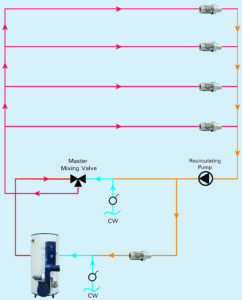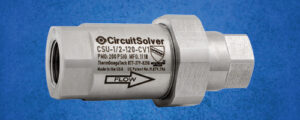When balancing a Domestic Hot Water System (DHWS), the goal is to ensure hot water is consistently available at every fixture throughout a building on-demand.

This can be difficult with manual balancing methods, which can deplete time, money, and labor resources.
Multiple contractors must manually balance one valve at a time, often revisiting the same valve several times to adjust for inadequate flow or temperature throughout the system.
The manual balancing process is both laborious and time-consuming. In the end, it may still result in future callbacks as system demands evolve because they cannot react to dynamic changes in the DHWS.
In comparison, thermostatic balancing valves like ThermOmegaTech’s CircuitSolver® valves use thermal actuator technology to automatically and continuously adjust flow through a domestic hot water recirculation system.
These self-actuating valves are installed at the end of each branch or riser before the return line to monitor the water temperature and will modulate open and closed to maintain a set temperature in each supply line.
How CircuitSolver® Thermostatic Balancing Valves Operate:
During the initial start-up of a DHWS, the valves are wide open and will begin to close once the system temperature requirements are met. During post-startup operation, each valve operates independently, establishing flow as needed to meet the system’s variable hot water demands throughout the day.
The valves will never fully close, always allowing a small amount of bypass of flow to the return to avoid dead-heading the recirculation pump during low usage.
CircuitSolver® is a temperature device that solves a temperature problem.

Through this entirely hands-off method, a DHWS using CircuitSolver® valves is balanced in a short time and can dynamically adapt to evolving system needs.
Compared to these thermostatic balancing valves, manual valves are simplistic, antiquated, and produce high labor costs.
The Savings
We surveyed plumbing contractors nationwide on domestic hot water system balancing costs and determined that CircuitSolver® thermostatic balancing valves generate significant cost savings by eliminating manual balancing labor.
The survey collected data on total costs associated with balancing a system, including labor time, employee salaries, required contractors per job, frequency of callbacks, and materials used. Below are the findings on the average cost of balancing the DHWS of a 10-story building.
CIRCUITSOLVER® BALANCING SAVINGS
| ITEM | CALCULATION | COST | |
| Manual Balancing Valve | 10 valves x $70 each | $700 | |
| Labor | Contractors x 12 hours x $65/hour | $1,560 | |
| Total Cost | $2,260 | ||
View the PDF here.
